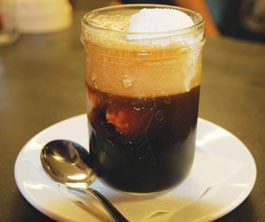The fridge of the average starving student usually contains few items, but one is most likely beer. Pop a cold one to drink with leftover ramen and a mustard packet, and a makeshift meal materializes. How about beer with ice cream? Over breakfast cereal? As salad dressing?
While college students’ odd combinations stem from lack of choice, experienced chefs are producing new menu items using just as odd, albeit more appealing concoctions. As craft breweries continue to produce beers with unusual flavors and higher drinkability, the options for creating dishes that complement and contrast with them grows. Thinking beyond typical pub grub like burgers or pizza, chefs are pushing the boundaries of beer and food combinations. Think grapefruit salad, blue cheese cake, banana tamales—and yes, breakfast cereal.
“There are really no rules,” says Billy Reid, executive chef at Sebastopol’s Hopmonk Tavern. “We just go with what works.” Sitting in the tavern’s dark red booth, Reid describes a deliciously creamy cheesecake he created using a Pt. Reyes Blue cheese and an Anderson Valley IPA. “It sounds stranger than what it really is—cream cheese and blue cheese with a little bit of sweetness, and it really worked, 100 percent. Most of this stuff is just dorkin’ around and seeing what we come up with.”
Joining the discussion, Hopmonk owner Dean Biersch weighs in on the chemistry behind the cohesion of the ingredients. “The blue cheese cake—that was one of the love connections that totally snapped,” says Biersch. “Black IPA has borderline sweetness and massive bitterness that weighs down and is resinous on your palate. The bitter and sweet flavors really work.”
While wine drinking has long gone by the basic rule of “white wine with fish, red with meat,” beer connoisseurs follow a much broader range of guidelines for pairing food with beer, depending on the ratio of the beer’s primary ingredients (water, hops, barley, yeast) and any additional flavorings to enhance the beer (chocolate, spices, coffee, nuts, fruits, pine tips, hemp, you name it).
“My job’s harder now,” says Reid. “It’s no longer pairing beer to the food, it’s pairing food to the beer. People come here first and foremost for the beer. They’re more cultured and know more about beer than they ever did.”
Many of the basic pairing guidelines echo common sense. Lighter beers, like lagers and pilsners, marry well with lighter foods, and darker beers like porters and stouts with richer, heavier foods. Seasonality comes into play; people prefer lighter meals and beer in hot weather and heartier fare during colder seasons. Many complement or contrast flavors, serving a dark roasted barley malt beer with roasted or barbecued meats, for example, or pairing a bitter, hoppy beer with sweet foods. Finding a balance is the key.
Carbonation and bitter flavors cut through oiliness and spicy heat, making pale ales, pilsners and lagers good mates for fiery dishes and cheesy foods like pizza. Experimenting with ingredients while keeping these guidelines in mind has yielded some strange but delicious bedfellows, like banana tamales made with Dunkelweizen, or a chocolate-and-Lagunitas Hairy Eyeball Ale chicken mole. “By definition we are open to taking beer and everything we do in Sonoma County to new places,” says Biersch. “I love that. Coming from Northern California, it’s a really great thing that we do here.”
Ron Lindenbusch, self-designated “Head Beer Weasel” and CFO at Lagunitas Brewery in Petaluma, also holds the enviable job of consulting with restaurant chefs for beer pairing dinners nationwide. Lindenbusch recalls a dinner held at The Melting Pot, a fondue restaurant in Larkspur, where every course contained beer. The sharp cheddar and Swiss fondue entr–e included Hop Stoopid Ale, an uber-hoppy beer, as a prime ingredient.
“This brought out some bitterness, which wasn’t a bad thing,” Lindenbusch says. “There are certain times when bitterness can be complementary, and not overpowering. Along with the carbonation, it lifts the oiliness off the tongue and clears the palate between bites.”
Lindenbusch describes substituting beer in classical dishes that usually use wine, like beurre blanc sauces made with Czech pilsner or Little Sumpin’ Sumpin,’ a seasonal wheat ale. Beer-based salad dressings made with a fruity ale or a light beer blended with white wine and balsamic vinegar have graced fresh greens, while pan-roasted barley malt crystals substitute for croutons. “A dusting of ground malt crystals over ice cream or on a stout ice cream float is absolutely delicious,” Lindenbusch says. “They taste like Grape Nuts cereal.”
And yes, combining beer and breakfast cereal has caught on. “We made a Count Chocula tiramisu with a black IPA,” says Hopmonk’s Reid. “Instead of lady fingers, I used Count Chocula. I lined the bottom of a snifter with cereal, and layered it with mascarpone, chocolate cake, and a lightly sweetened Chantilly whipped cream. Then we poured the black IPA over it and the cereal soaked it up. It was really fun. Beer is pretty versatile.”











